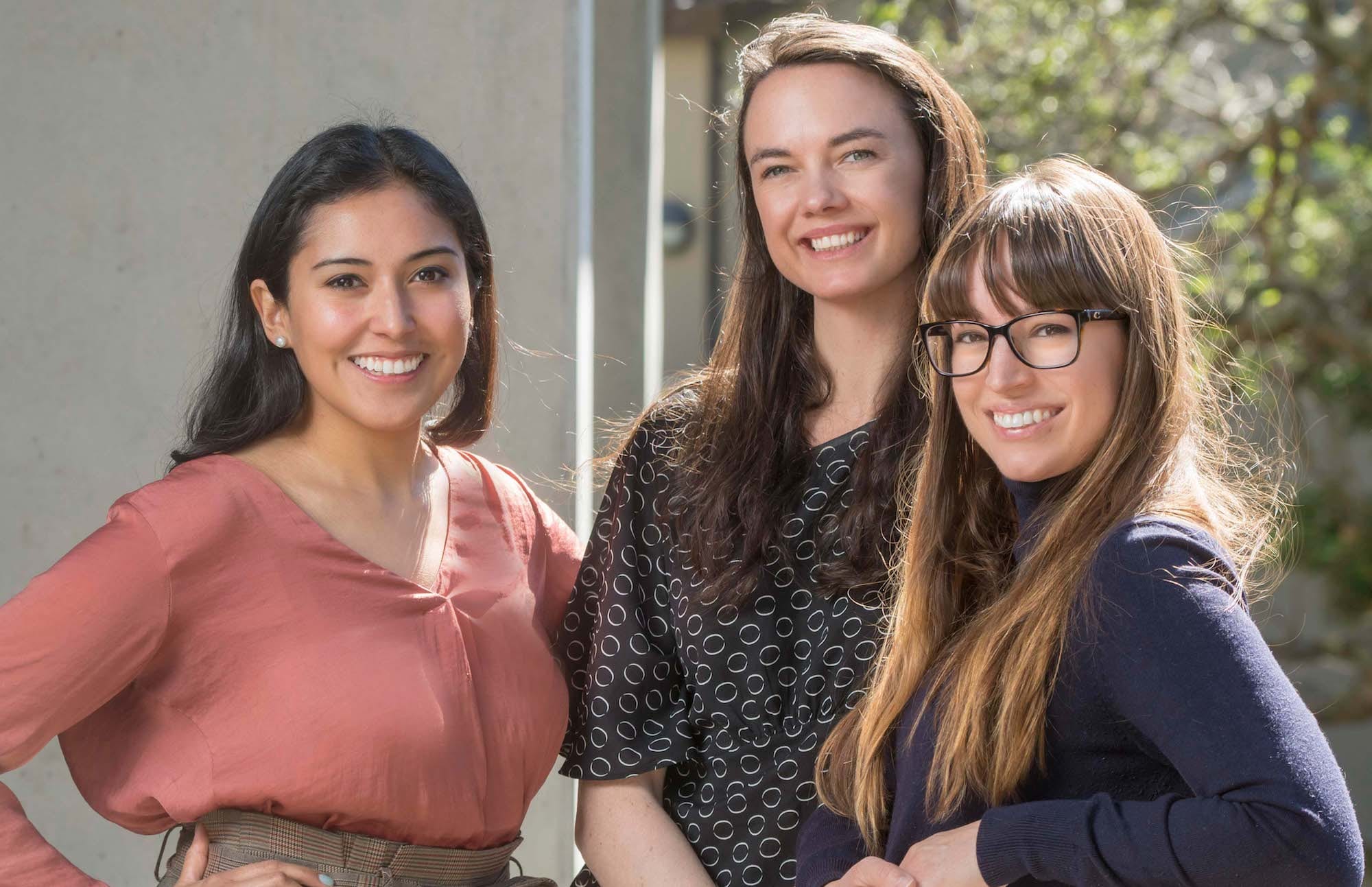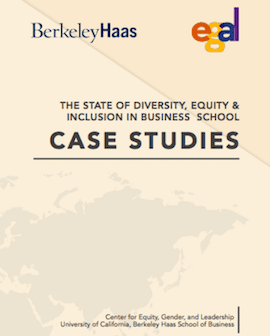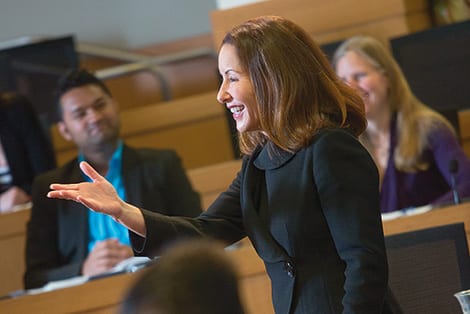
As a student in the MBA for executives program, Adam Rosenzweig found that most of the cases used to teach real-world business problems in his classes often featured the same sort of leader: a white male.
“Our experience was definitely that case protagonists were overwhelmingly not diverse,” said Rosenzweig, EMBA 19, now a Haas lecturer teaching Introduction to the Case Method in both the EMBA and Full-time MBA programs.
Feedback from MBA students like Rosenzweig—who co-wrote a case with a female protagonist last year with senior Lecturer Drew Isaacs—and faculty members inspired the Center for Equity, Gender and Leadership (EGAL) to dig into the problem. That digging led to a catalog of diverse business cases called the EGAL Case Compendium. The compendium, a spreadsheet shared with the Berkeley Haas faculty this month, includes 215 cases with diverse protagonists and 215 cases specific to Diversity, Equity, and Inclusion (DEI) topics.
“A general lack of diversity”
The project, led by Genevieve Smith, associate director of EGAL, was partly funded by a $5,000 Haas Culture grant that the center’s Program Director Jennifer Wells applied for last year.
Smith argues that the limited range of protagonists in typical business cases is a longstanding problem that leaves students with gaps in understanding the connection between classroom learning and future workplace environments.
“This lack of diversity perpetuates a status quo in which traditional business leaders are primarily both male and white,” she said. “We see this as a big problem in business schools globally, and if we’re going to address the gaps around diversity in business, we need to address it in business schools.”
It’s a problem that impacts all business schools who use published cases, Smith said. Harvard Business School publishes the vast majority—some 19,000 cases—which represent roughly 80% of the cases used in business schools globally. Just over 1% of those Harvard Business Review cases include an African-American/Black person as a protagonist, and 9% include a female protagonist, the team estimates based on its analysis.
“That the majority of cases taught in business schools center on white men in 2020 is unacceptable,” said Kellie McElhaney, founding director of EGAL and a Haas faculty member. “If we hope to educate students who are equity fluent leaders, it will require a sweeping effort on the part of business schools and their faculties to make changes.”
That the majority of cases taught in business schools center on white men in 2020 is unacceptable.
Including people of different races, ethnicities, genders, ability, sexual orientation, and religions will help on multiple fronts—from increasing awareness of different life experiences, to fostering sensitivity among students, to helping with recruitment of students who “need to see themselves represented as leaders,” Smith said.
Cases that perpetuate stereotypes
To build the Case Compendium, EGAL hired research assistant Diana Chavez-Varela, BA 19, (now a summer legal investigator at Berkeley Law’s Human Rights Center), who began by searching existing cases under many keywords related to diversity, cataloguing the cases by author, topic, discipline, target segment, identities of focus, and industry sector.

She also flagged discriminatory language against any group, noting a few standout cases that perpetuate stereotypes including “Director’s Dilemma: Balancing Between Quality and Diversity,” a headline that infers that companies that hire for diversity sacrifice quality. Another case study summary: “How do you manage talented people who are different from the typical corporate profile — like women, Blacks, Asians, Hispanics, and others?” presents white men as “typical” and other people as “atypical.”
Most of the non-white-male protagonists that Chavez-Varela found in the 215 cases were women (84%)—primarily white females working in the human resources management or organizational behavior areas. Cases with female protagonists also largely touched on topics like culture and workforce representation, but failed to address other issues such as labor rights, government policies, workplace harassment, or challenges for dual-career couples.
The researchers, who also wrote a report based on their findings, found that more than half of the cases that centered on topics related to DEI in the business world focused on advancing DEI among entry- and mid-level employees, with just 15% focused on more-senior leaders. And among DEI cases, the most common focus was advancing women in the workplace—with fewer focused on race, ethnicity, or other identities.
“There is much room to grow in terms of new DEI case studies,” Smith said. In particular, the EGAL team is interested in supporting the faculty and writing new cases with protagonists representing intersectional identities and in industries/disciplines outside of HR and organizational management, and on DEI-related topics that are relevant to core courses.
There is much room to grow in terms of new DEI case studies.
Prof. Catherine Wolfram, associate dean for academic affairs & chair of the faculty, who shared the EGAL Case Compendium with the faculty, said she’s receiving positive feedback so far.
“There have definitely been discussions about addressing diversity topics in the classroom in faculty meetings and we’ve had people describe the issues that have come up around the lack of diversity and the topics that students want to talk about,” Wolfram said.
What makes a good case?
While the Haas curriculum isn’t as case-driven as many other business schools, such as Harvard Business School, faculty members still consider cases integral to teaching.
Some of those cases are homegrown, written by Haas faculty and published as the Berkeley Haas Case Series (BHCS).
Five Berkeley Haas cases included in EGAL’s Case Compendium include—Promoting a Culture of Equity in the #MeToo Era: Moving Beyond Responding to Gender-Related Workplace Issues to Tackling Root Causes (written by McElhaney and Smith); Zendesk: Building Female Leaders Through Mentorship (co-written by McElhaney); Eliminating the Gender Pay Gap: Gap Inc. Leads the Way (written by McElhaney and Genevieve Smith); The Berkeley-Haas School of Business: Codifying, Embedding, and Sustaining Culture (written by Prof. Jennifer Chatman with former Dean Rich Lyons); and People Operations at Mozilla Corporation: Scaling a Peer-to-Peer Global Community (written by Senior Lecturer Homa Bahrami).

Chatman, an expert on culture who teaches organizational behavior, said EGAL is helping to raise awareness of the diversity problem in business school cases by both cataloguing and providing an easily searchable clearing house. Chatman, who writes a case every four or five years, has long been a leader in featuring diverse protagonists, such as leaders at Genentech and Walmart.
Yet she acknowledged the challenges with overhauling business school curricula, adding that many professors try to avoid switching cases too frequently due to the difficulty in finding well-aligned cases. “The case needs to be timely, relevant, and it needs to be about an organization or industry that students will find interesting,” she said. “A good case is also easy to read, not too long, and will preferably include video—and the professor should be able to extend the story by easily adding material related to, but not included in, the case. So the list is long!”
“No magical solution”
Assoc. Prof. Dana Carney, who researches racial bias, power, and nonverbal behavior, says she’s always on the hunt for new cases that are relevant to her courses. She agrees that cases with diverse protagonists—particularly race/ethnicity— are hard to find.
Carney currently uses five cases, two with a total of 4 female protagonists, one with predominantly male protagonists (although ethnic/racial identities are ambiguous), one with no protagonist, and two more with ambiguous race/ethnicity and names that could be either female or male because only last names are used.
“I’m always looking, always thinking of cases I could and should write, always trying to be inclusive and evolve,” Carney said.
For example, Carney, along with Economics Prof. Paul Gertler, developed a negotiation case with Ugandan protagonists to be used in Uganda. But the case is so culturally bound to the Ugandan context it wouldn’t be usable in a U.S.-based undergraduate or MBA business context, she said. The bottom line? “We need more cases,” she said.
While there’s no magical solution to the case dilemma, Prof. Don Moore came up with one idea that might help: a spreadsheet Berkeley Haas faculty are using to list cases taught in their own core classes. Faculty interested in finding a diverse case may now cross-check on the EGAL list to see if there’s a match between a case that’s included on both lists, he said.
(Read EGAL’s full report, The State of Diversity, Equity & Inclusion in Business School Case Studies, here, or the executive summary here.)